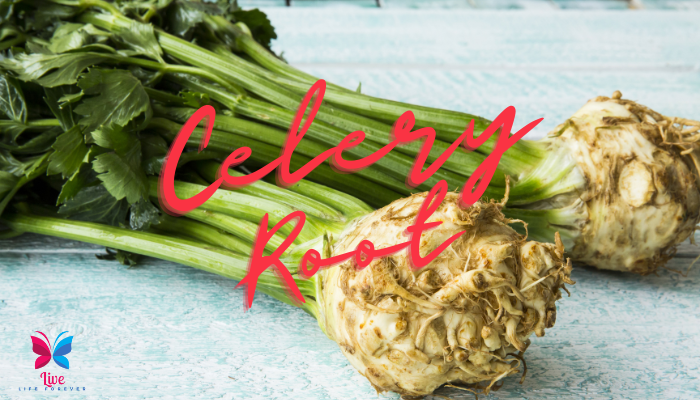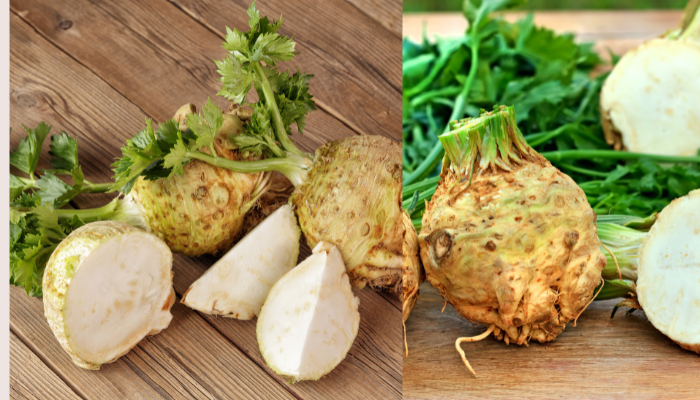The Humble, Heart-Healthy Celery Root: An Underappreciated Vegetable Worth Discovering


Celery Root
Celery root, also known as celeriac, is an unassuming vegetable, to be sure. Lacking the bright colors of carrots or the intriguing shapes of potatoes, it is often overlooked among more eye-catching produce options. However, behind its rough and knobby exterior lies a world of culinary potential and nutritional benefits that should not be ignored. Read on to discover the incredible versatility, rich flavor, and health perks this humble root has to offer.
What is Celery Root?
Perhaps the biggest barrier to celery root achieving wider popularity is simply its obscurity. Many consumers have never heard of it, let alone tasted it. So what exactly is celeriac?
Celery root is a variety of celery grown specifically for its edible hypocotyl and taproot rather than its stalks and leaves. While it lacks the familiar stringy stems of common celery, it boasts a more intensely concentrated, aromatic celery flavor. In fact, the entire plant contains the same phthalides that give celery its signature taste and smell. The root itself has a crisp, starchy, savory quality with tangy and nutty notes similar to parsley root, but cleaner and fresher tasting overall.
Despite its moniker, celeriac is not actually the swollen root of traditional celery. Instead, it derives from a special celery cultivar (Apium graveolens var. rapaceum) bred solely for its bulbous base rather than ribbed stalks. Over time, celeriac was further developed to minimize foliage and long stems in order to channel the plant’s energy towards enlarging its hypocotyl and taproot.
Other common names for celeriac include turnip-rooted celery, knob celery, and celery knob. Europe and North Africa boast the longest history using it as a food crop. However, it has become increasingly exported to other regions where it continues gaining traction for its versatility in various cuisines.
Identifying Celery Root
When shopping for celeriac, keep your eye out for large, heavy, firm spheres ranging from baseball to softball size with brown papery skin and an inner white flesh. Older, overgrown roots tend to get hollow and pithy around the center, making them less ideal, so select specimens that feel dense all the way through. The taproot and lower portion of the hypocotyl are the most tender and flavorful sections to consume.
Celeriac roots grow just below soil level, where small feeding roots surround the surface. Avoid specimens with numerous bulbous protrusions, cracks, mold, or black spots. The skin and all traces of dirt must be peeled, but roots in peak freshness should exhibit a smooth, mostly spherical shape underneath with a creamy white interior maintaining faint hints of greenish-yellow or light gray.
Nutrition and Benefits
Don’t let its starchy composition fool you – celeriac packs some serious nutritional value. In just one raw cup:
- Fiber: 5 grams – Stimulates digestion, balances blood sugar
- Potassium: 769 mg – Supports fluid balance, nerve transmission, heart health
- Phosphorous: 150 mg – Fortifies bones, aids metabolism
- Iron: 1.28 mg – Boosts red blood cell formation, oxygen circulation
- Magnesium: 43 mg – Regulates muscle, nerve function, metabolism
- Vitamin C: 73% DV – Encourages collagen production, immunity
- Vitamin K: 21% DV – Assists blood clotting, bone density
- Vitamin B6: 15% DV – Sustains nervous system, energy levels
- Manganese: 15% DV – Assists bone structure, metabolism
- Calcium: 11% RDI – Strengthens bones and teeth
As a low-carb, nutrient-dense whole food, celery root offers antioxidants and phytochemicals that control inflammation and protect cells. Its high fiber content supports digestive health and heart health by regulating cholesterol. The vitamins and minerals celeriac provides even further reduce cardiovascular disease risk while promoting proper muscle, nerve, and metabolic functionality.
The inclusion of certain flavonoid antioxidants could help combat cancer by eliminating free radicals within the body. Some early research indicates the phthalides unique to celery may also lower blood pressure, though more studies are still needed. Nonetheless, adding celery root to one’s diet constitutes an easy way to incorporate beneficial nutrition into meals.
Purchasing and Storage
Celeriac has an exceptionally long storage life compared to most other fresh produce items. Kept dry, clean, and cold, whole roots can last over six months. Avoid washing them until ready to use, as excess moisture quickens deterioration. Simply trim off stalks and rootlets first with a knife, brush off any remaining dirt clumps (no need to fully peel yet), then place uncut roots in a perforated plastic bag inside the crisper drawer of your refrigerator.
Properly stored celery root will keep fresh for at least one to three months when left intact. Once peeled and sliced, it holds for about five days when refrigerated in an airtight container fully submerged in water to prevent oxidation. Freezing cut pieces for future usage is another excellent preservation method, allowing celeriac to retain its texture better than many other frozen produce options.
Where to Find Celery Root
Due to its long shelf life that facilitates importation, celery root can be found year-round in most major grocery stores. Seek it out near other root vegetables like potatoes, onions, turnips, carrots, parsnips and beets. Availability peaks around fall through early spring. Try your local supermarket, natural food market, farmers market or farm stand. Being a relatively obscure vegetable, not all retailers carry celeriac consistently, so you may have to search around a bit.
Cost*
As a humble, unsung hero of the produce world rather than a trendy superfood, celery root remains highly affordable. Prices typically run between:
- $1 – $3 per pound
- $2 – $4 each for large single roots weighing 1-2 pounds
*Prices may fluctuate based on season, demand and location

Preparation Tips & Handling
Celeriac requires a bit more hands-on prep than most vegetables since the fibrous outer skin and tiny root hairs must be removed. To peel, first slice about 1/4 inch off the top and bottom ends, then stand the cylinder upright and carefully slice downward from top to bottom removing the tough skin in thick strips working around the entire surface. A sturdy vegetable peeler can also work once you peel deep enough past the rootlets.
Beneath lies a smooth white flesh that offers mild resistance when cut, similar to a potato or turnip. If any brownish-green patches remain on the interior flesh, continue peeling deeper until fully removed. Rinse under cool water after peeling to eliminate dirt or debris clinging to crevices. Slice, dice or cut into wedges as desired before use.
When prepping celery root, having a bowl of acidulated water (water mixed with a teaspoon of lemon juice or white vinegar) nearby is recommended to place peeled and sliced pieces into in order to prevent discoloration until ready to cook. Its white flesh will quickly oxidize and turn an unappealing grayish-brown once exposed to air and light if left sitting long.
Sweet yet earthy, the entire celery root can be consumed cooked or raw. However, the taproot and lower hypocotyl offer superior tenderness to the upper neck and shoulders. The tough, fibrous flesh closest to the skin always gets discarded as well. Many recipes suggest salting sliced celeriac before cooking to help draw out excess moisture for better caramelization.
Popular Pairings & Cuisine Contributions
The natural savory herbaceousness of celery root allows it to blend seamlessly into a wide array of cultural dishes spanning from its native French origins to Mediterranean, Middle Eastern and Eastern European cuisines. It also adapts readily to modern applications giving plant-based, gluten-free and paleo diets a new way to rethink root vegetables thanks to celeriac’s lower carb yet nutrient-dense properties.
In Europe, celery root often substitutes for or supplements potatoes. It produces rich stews, gratins and mashed textures with cleaner flavors compared to regular russets or sweet potatoes. Sautéed in butter or olive oil, puréed into velvety soup bases or roasted until tender and caramelized, celeriac exemplifies why the French nickname it “celerisot” – adding notes as delicious as the prized truffle for which it playfully pays homage.
The bright herbal qualities celery root contributes to recipes allows it to accentuate greens, beans, tomatoes, mushrooms and stronger herbs like rosemary, thyme, sage and parsley beautifully. In salads, celeriac’s firm crunch offsets softer lettuces while its slight peppery bite balances fatty, rich ingredients like cheese, nuts and dried fruit. It also makes an excellent candidate for pickling.
Many cultures utilize celeriac in traditional holiday dishes, much like potatoes or turnips. Germans whip up celeriac remoulade for Oktoberfest while French Christmas feasts might feature celery root paired with delicate truffles. It also works well mixed into mirepoix base ingredients of onions, carrots and celery – hence its literal translation as “celery root.”
Common Dishes Showcasing Celery Root
Some classic examples of beloved recipes featuring celery root include:
- Mashed Celeriac: Vegan alternative to mashed potatoes
- Celeriac Remoulade: Cooked and chilled celeriac mixed with mustard, herbs, lemon and mayo
- Celeriac Risotto: Hearty rice dish with the addition of celeriac
- Celeriac Soup: Unique spin on potato leek soup by using celeriac
- Roasted Celeriac: Coated in oil and spices then oven roasted
- Celeriac Fries: A delicious colored alternative to regular French fries
- Celeriac Gratin: Baked casserole with cream and cheese
- Celeriac & Apple Salad: Thinly sliced celeriac and apple with vinaigrette
- Celery Root Slaw: Shredded celeriac paired with classic creamy slaw dressing
- Celeriac Mash: Mashed celery root makes tasty potato substitute
The knobby cork-shaped corm has applications well beyond Europe too. Its nutty savoriness shines in many Middle Eastern and Indian-style curries, stews and salads. Try using it as the base vegetable instead of potato in dishes like samosas, biryani or dopiaza. Blend celeriac with garam masala, cumin, mustard seed, turmeric and coconut milk for an exotic twist.
In lighter preparations, matchstick the raw celery root into slaws or simply shave into thin slices to eat alone or dip into sauces and dressings like hummus, ranch, blue cheese, etc. Let celeriac stand front and center on its own merits, accentuated with a drizzle of olive oil and fresh herbs.
For heartier fare, dice it uniform and get creative swapping celeriac into fried rice, taco filling, frittatas, pastas, stuffed peppers, flatbreads or even baked into bread. Its versatility truly knows no bounds across a wide swath of world cuisine.
Selection Criteria
When selecting celery root specimens for purchase, ideal candidates should exhibit:
- Compact, dense, heavy bulb with few blemishes
- Golf ball to small melon-sized roots work best
- Avoid overly large specimens, which tend to get woody
- Smooth skin free from substantial mold, cracks or bruises
- Fresh, bright green tops still attached
- Feels rock solid when gently squeezed (no soft spots)
- May have a few thin rootlet hairs protruding
Any specimen meeting most of those criteria makes a good choice for bringing home to prepare.
FAQs
Still hungry for more information on underrated celeriac? See answers to some frequently asked questions below:
Is celery root starchy like a potato?
Yes! It contains a similar amount of carbohydrates and starch as found in most potatoes. Celeriac makes an excellent stand-in for mashed potatoes with a richer, cleaner taste.
What does celery root taste like?
Celery root has a more intensely concentrated flavor of celery than the stalks, with earthier and nuttier nuances similar to parsley root. It tastes mildly sweet and savory with tangy, herbaceous notes. The flavor pairs well with dairy, citrus, herbs and greens.
Is celery root healthy?
Extremely! This humble vegetable overflows with important antioxidants, fiber, vitamins and minerals that benefit digestion, immunity, bones, muscles, nerves and heart health. It also helps regulate inflammation and blood sugar.
Is celery root good for weight loss?
As a lower glycemic index food full of nutrients and fiber that provide sustainable energy and keep you satiated, celery root supports healthy weight management and makes smart substitutions for higher carb ingredients.
Can you eat celery root raw?
Absolutely! Thinly slicing or shaving it raw to use as crudité for dipping or add to salads keeps its signature crunch intact. Raw celeriac makes a nutritious substitution for higher calorie snacks like chips or French fries.
Does celery root taste like licorice?
It contains traces of the same compound (apiol) that gives tarragon, parsley and fennel their faint anise-like flavor, but nowhere near prominent enough to liken celery root’s taste to licorice. It has a much cleaner, fresher, more savory flavor profile.
Conclusion
Hopefully this overview has shed some light on the incredible versatility of celery root as well as its nutritional merits that warrant it landing more frequently in shopping carts and on dinner plates. Don’t let its homely appearance deter you from trying this wholesome, hearty vegetable. With proper storage, access to celeriac has expanded into mainstream markets, so seek it out and begin experimenting with wonderful recipes featuring this humble bulb. Embrace celeriac today!




